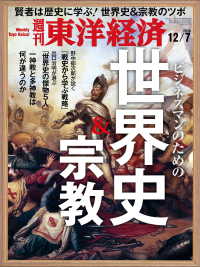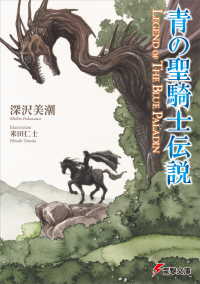- ホーム
- > 洋書
- > 英文書
- > Business / Economics
基本説明
The authors draw experiences and cases from the music industry, sports, fashion, creative and media organizations and what we might regard as more mundane providers of mainstream products and services.
Full Description
People tend to think of creativity and strategy as opposites. This book argues that they are far more similar than we might expect. More than this, actively aligning creative and strategic thinking in any enterprise can enable more effective innovation, entrepreneurship, leadership and organizing for the future.By considering strategy as a creative process (and vice versa), the authors define 'creative strategy' as a mindset which switches between opposing processes and characteristics, and which drives every aspect of the business. The authors draw experiences and cases from across this false divide - from the music industry, sports, fashion, Shakespearean theatre companies, creative and media organizations and dance, as well as what we might regard as more mundane providers of mainstream products and services - to uncover the creative connections behind successful strategy."Creative Strategy is a talisman for those looking to take a new path"-Matt Hardisty, Strategy Director, Mother Advertising"It has been said that business is a hybrid of dancing and calculation - the former incorporating the creative within a firm, the latter the strategic. Bilton and Cummings show how these apparently contradictory processes can be integrated. Their insights about how firms can 'create to strategize' and 'strategize to create' are informative for managers and management scholars alike."-Jay Barney, Professor and Chase Chair of Strategic Management, Fisher College of Business, The Ohio State University"In today's world, new thinking - creativity - is required to tackle long-standing problems or address new opportunities. The trouble is few organizations understand how to foster and apply creativity, at least in any consistent manner. This book provides new insights into just how that can be done. It moves creativity from being just the occasional, and fortuitous, flash of inspiration, to being an embedded feature of the way the organization is run."-Sir George Cox, Author of the Cox Review of Creativity in Business for HM Govt., Past Chair of the Design Council
Contents
Acknowledgements Prologue: When Strategy Meets Creativity1 False Separations and Creative ConnectionsOvercoming five false separationsFive creative connections for the future2 What is Creativity?1. Creativity's Content: Innovation + a purpose to add more than individual value2. Creativity's Outcomes: transforming contexts and redefining problems3. The Creativity Process: tolerating contradictions enables bisociative thinking3 Uncreative Strategy1. Creativity can't be planned directly2. Creativity requires bisociation, going between things, seeing from the edges, both/and rather than either/or thinking and can be thwarted by rigid classification3. Creativity requires plurality4. Creativity requires mistakes and accidents, or at least an acceptance of their value5. Creativity requires slack6. Creativity correlates strongly with an expectation that one should be creative7. Imagery is more likely to stimulate creative thinking than language on its own8. Creativity is often spurred on by a competitive tension9. Strategy is often associated with heroic leadership by individuals10. Strategic management, like management in general, has been more enamored with innovation as opposed to creativity4 A More Creative View of StrategyStrategy's content: plans, patterns, positions, ploys, perspectivesThe process of strategizing: designing, planning, positioning, learning, emerging, entrepreneuring, and so onThe outcomes of becoming strategized: orientation, animation, integration5 Creating and Discovering a Creative Strategy ProcessThe ROYAL SHAKESPEARE COMPANY: Setting the Scene for Creative StrategyPART I The Innovative Act: Discovery and Creation6 The Bisociations of Strategic InnovationThe Importance of Being InnovativeDefining strategic innovation: Discovering and Creating the New and Original7 The Six Outcomes of Strategic Innovation1st Degree of Strategic Innovation: Value InnovationThe 2nd Degree of Strategic Innovation: Cost innovationThe 3rd Degree of Strategic Innovation: Volume innovationThe 4th Degree of Strategic Innovation: Market innovationThe 5th Degree of Strategic Innovation: Boundary innovationThe 6th Degree of Strategic Innovation: Learning innovation8 Sparking Strategic InnovationDiversityNaivetyCuriosityUrgencyBeyond best practiceThe ROYAL SHAKESPEARE COMPANY Act I: The Innovative ActPART II Strategic Entrepreneurship: Dilettantes and Diligence9 The Five Angles of Strategic EntrepreneurshipThe force of a creative strategyThe five angles of strategic entrepreneurship1st Angle of Entrepreneurship2nd Angle of Entrepreneurship3rd Angle of Entrepreneurship4th Angle of Entrepreneurship5th Angle of EntrepreneurshipThe Cycle of Strategic EntrepreneurshipFrom Cycle to Interconnected StarThe strategic entrepreneur as a `diligent dilettante'Creative thinking games for diligent dilletantes10 Three Angular Journeys of EntrepreneurshipAbout a writer-entrepreneur12 000 miles to marketDeciphering CodemastersThe ROYAL SHAKESPEARE COMPANY Act II: The Entrepreneurial ActPART III Strategic Leadership: Envisioning and Interacting11 Leading from the MiddleAll Roads Lead to the MiddleRoute 1: The rise of the `knowledge age'Route 2: Working with the `wisdom of crowds'Route 3: Rediscovering of the importance of the `gut instinct' and intuitionRoute 4: Tipping rather than chargingRoute 5: The power of networks and relationshipsRoute 6: From IQ to many QsRoute 7: `Post-heroic' leadershipRoute 8: Strategy from the middle12 The Strategic Leadership KeypadSwitching Positions: Introducing the strategic leadership keypad13 Shifting Keys: Leadership as Envisioning and Interacting1. Leading ugly: Billy Beane2. Leading without `leadership': Arsene Wenger3. Leading by whispering: Bill Campbell4. Reconnecting Leadership: Saatchi & SaatchiFrom Strategic Leadership to Strategic OrganizationThe ROYAL SHAKESPEARE COMPANY Act III: The Leadership ActPART IV Strategic Organization: Focussing and Loosening14 From Principles of Excellent Organizations to Organizational `Virtues'SLTIcarus, Aristotle and The Virtue of Virtues15 Seven Virtues of Strategic OrganizationThe 1st Virtue: Integrating and fragmenting: Adaptive cultureThe 2nd Virtue: Democracy and dictatorship: Meritocratic politicsThe 3rd Virtue: Naive and expert: Deutero-learningThe 4th Virtue: Subjective and disembodied: development from everywhereThe 5thVirtue Distracted and blinkered: A multi-tasking orientationThe 6th Virtue: Open planned and closed planned: Ambidextrous architectureThe 7th Virtue Static and flux: poised for change16 Strategic Organization: Where Creative Strategy Ends (And Begins Again)Organizing for creative strategy: Getting the particular balance rightOrganizing Creative StrategyThe ROYAL SHAKESPEARE COMPANY Act IV: The Organizational ActSources and Suggested Further ReadingReferencesIndex








